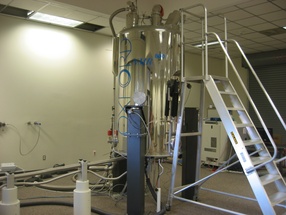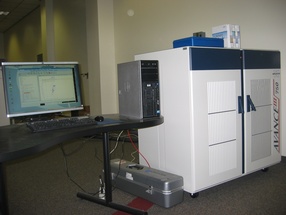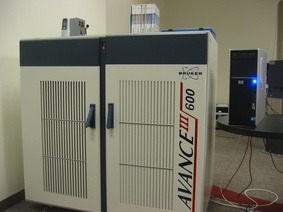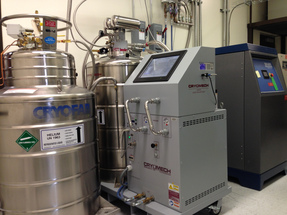Nuclear Magnetic Resonance (NMR) Spectroscopy
-
Introduction
Nuclear magnetic resonance (NMR) spectroscopy is a versatile tool that provides information on structures and dynamics of various biological and synthetic molecules at an atomic level. The SCSB NMR Laboratory is located in its own two-story building ( NMR Dockside Building ) on the UTMB campus at Galveston. Currently, the following three high-field NMR spectrometers are available at the facility:
- Bruker Avance III 800 MHz spectrometer with a 1H⁄ 2H ⁄ 13C ⁄ 15N TCI cryoprobe
- Bruker Avance III 750 MHz spectrometer with a 1H ⁄ 2H ⁄ 13C ⁄ 15N TCI cryoprobe
- Bruker Avance III 600 MHz spectrometer with a 1H ⁄ 2H ⁄ 13C ⁄ 15N ⁄ 31P QCI cryoprobe
These instruments are capable of various multi-dimensional heteronuclear 1H ⁄ 2H ⁄ 13C ⁄ 15N ⁄ 31P NMR experiments. For the 750 MHz spectrometer, a diffusion broadband (DiffBB) probe capable of generating up to 270 gauss/cm field gradients is also available for diffusion experiments on various ions (e.g., 23Na+, 7Li+,19F-, 133Cs+). For stability of power supply, high-capacity UPS units protect the NMR spectrometers. A Cryomech LHeP22 helium recovery system recovers helium gas from the three NMR magnets and liquefies it for reuse, which reduces operating costs for the NMR equipment.
Major applications of NMR to biomedical research include (but not limited to):
- Determination of 3D structures of biological macromolecules
- Structural dynamics of proteins and nucleic acids
- Macromolecular kinetics & thermodynamics
- In-cell ⁄ in-situ analysis of proteins
- Metabolomics
- Fragment-based drug discovery
The SCSB NMR Laboratory offers instrumentation, training, collaboration and assistance in designing NMR experiments. The 800 MHz NMR spectrometer is a shared resource of the Gulf Coast Consortia.
-
Instruments


800 MHz 750 MHz 

600 MHz Cryomech LHeP22 
MB-TIG 1010 Welding Glovebox
-
Documentation
- SCSB-Usage-Form (PDF)
- Usage-Form-Instructions (PDF)
- NMR 800MHz
- NMR 750MHz
- NMR 600MHz
- MB-TIG 1010 Welding Glovebox: Researchers will need to purchase the supplies needed for operation for their experiments. Please contact the NMR resource manager, Dr. T. Wang.
- Facility Acknowledgement for Manuscripts and Posters
- Facility Description for Grants
- NMR Scheduling Policy
-
Software
NMR Theory and Tutorials
The basics of NMR - Overview of NMR
NMR Pulse Sequences
These programs were developed at UTMB by Prof. Junji Iwahara's group: Iwahara Group Software
- NMR pulse programs to study dynamics of lysine side-chain NH3+
- NMR pulse programs for triple resonance experiments to assign lysine NH3+
- NMR pulse programs for 1H PRE rates Γ1 and Γ2 measurements
- TDSK for kinetic analyses of protein translocation on DNA
Analysis Programs Available on the SCSB Compute Servers
-
Contact
For more information please contact the SCSBMB NMR manager.
Manager: Tianzhi Wang, PhD
E-mail: tiawang@utmb.edu
Tel: (409) 747-6821Advisory Committee
- Werner Braun, PhD
- Junji Iwahara, PhD
- Krishna Rajarathnam, PhD
- Mark A. White, PhD, Manager, X-ray Crystallography Laboratory
-
Scheduling
New users and current users who have new research projects and/or new grants are asked to please complete the Usage form:
Instrument Scheduling
-
FAQs
- How do I cite the NMR facility on my poster?
Suggested Acknowledgement
"The authors acknowledge the Sealy Center for Structural Biology and Molecular Biophysics at the University of Texas Medical Branch at Galveston for providing research resources."
"The authors acknowledge the W. M. Keck Foundation and the John S. Dunn Research Foundation for the funding for the 800 MHz NMR spectrometer."
